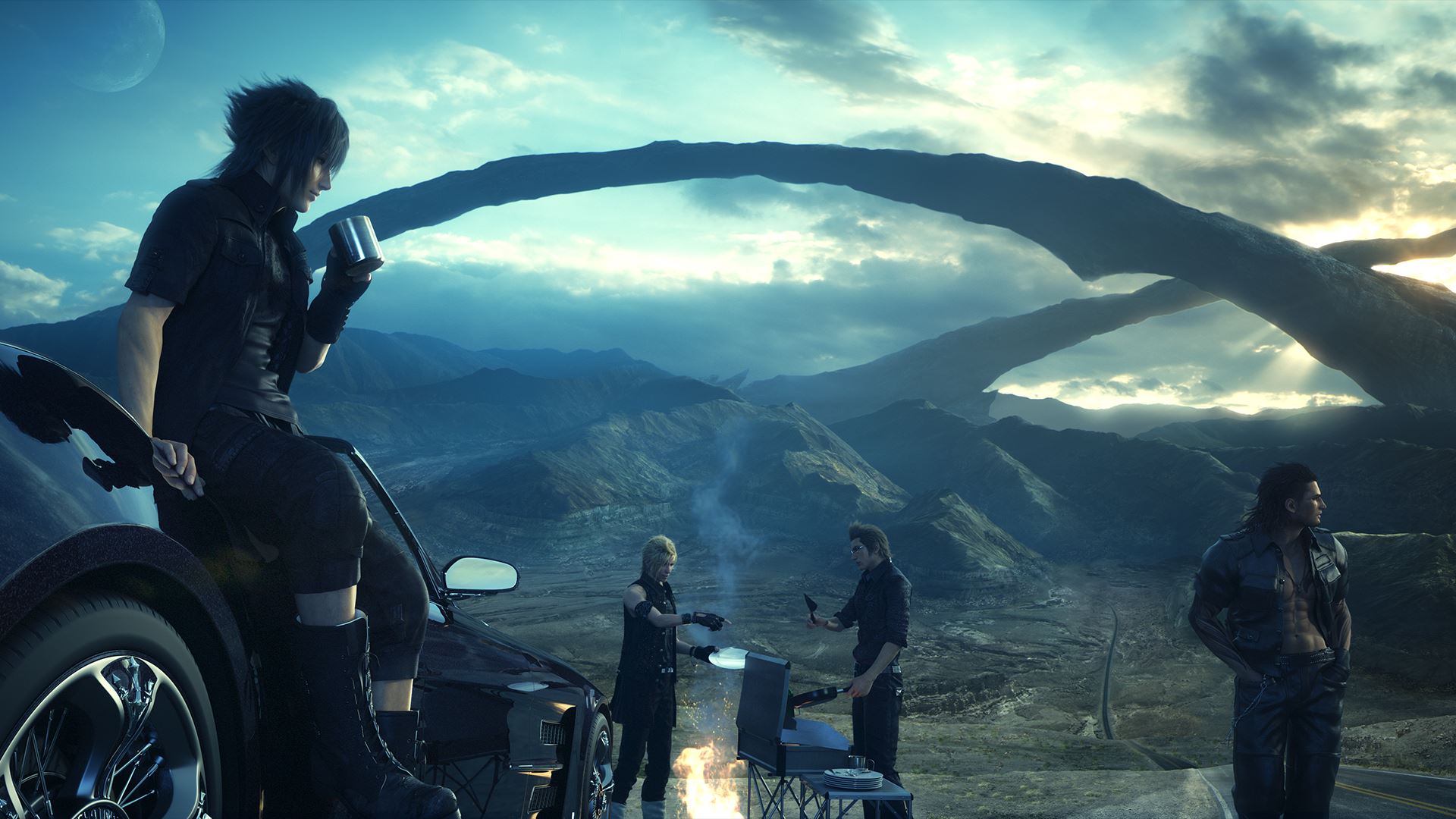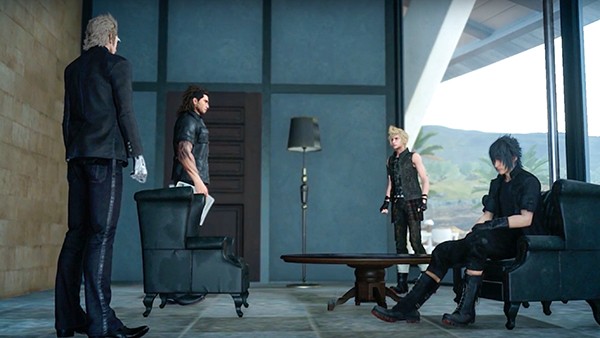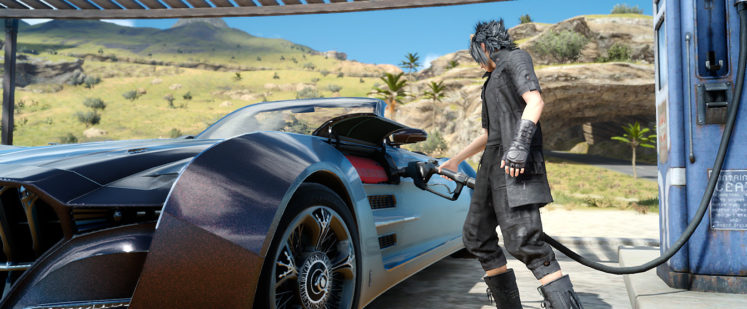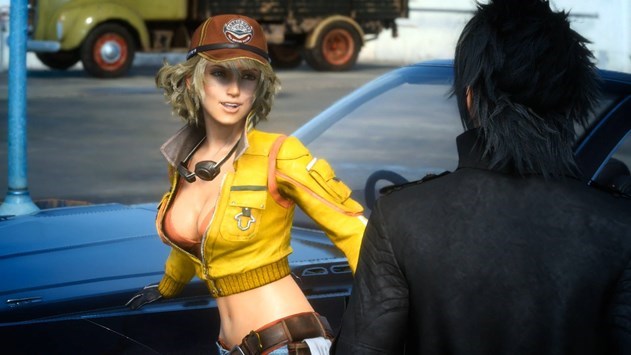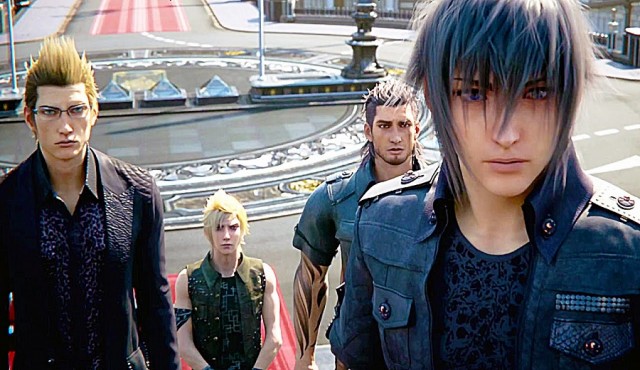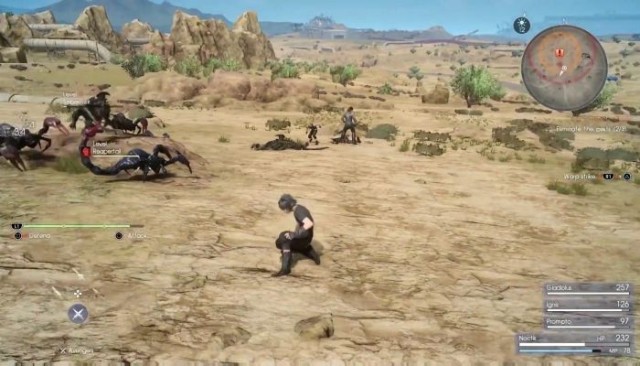Final Fantasy XV has had two separate demos that have been made available to the gaming public, one offered to anyone with access to the PlayStation Store/Xbox Games Store, and the other exclusively offered to first-run purchasers of Final Fantasy Type-0 HD on a console. Both of those demos offered select in-development snippets of the lengthy RPG adventure that will be finally released to the public, after a long ten years of development, at the end of this month. At a recent Square Enix media summit however, I was able to play a good chunk of the game’s final retail build ahead of release, to enjoy about 45 minutes of Final Fantasy XV’s opening section.
The version I tested personally was the PlayStation 4 build, on a standard PlayStation 4 console (sadly, I wasn’t able to preview the game on the brand new PlayStation 4 Pro), though I was able to view some of another play test of the game’s Xbox One version. At first blush, it seems like the two versions of Final Fantasy XV are pretty much indistinguishable. The Xbox One version allegedly renders its graphics closer to 900p resolution, versus a perfect native 1080p resolution on PlayStation 4, though this difference in pixel count isn’t truly noticeable if you’re not running both versions beside one another. Regardless of your console of choice, both builds are visually superb, and they both seem to run at a steady 30fps clip with no slowdown, with a 60fps upgrade promised in a future update for PlayStation 4 Pro owners. Final Fantasy XV’s initial load time is pretty long on both a standard PlayStation 4 and Xbox One, on the negative side, seemingly stretching upwards of twenty seconds, but once that load time is out of the way, you can at least enjoy the seamless world with no real interruptions outside of cutscenes. Fortunately, saving your game, which can be done anywhere outside of an active quest location or battle, is pretty speedy, to compensate.
Needless to say, Final Fantasy XV is shaping up to be a vast, beautifully-presented and memorable RPG experience that makes a fantastic first impression! Whether the game keeps up that appeal in the later reaches is something for reviewers to decide around launch, but one’s first moments with the game are genuinely captivating, as Final Fantasy XV doesn’t feel quite like any other RPG on the market, Japanese or Western. This constant ability to innovate and surprise with each new mainline installment is a hallmark of the Final Fantasy brand, but Final Fantasy XV takes an especially big leap into modern gaming sensibilities, having abandoned the turn-based battle system of the series’ former installments, and re-aligned itself with a greater emphasis on surprising realism, and accessible, but deep gameplay mechanics.
The opening stretch of gameplay I enjoyed mostly echoed the 45-minute opening showcase trailer that came out of this year’s Gamescom, but as anyone who played one or both of the demos could tell you, watching Final Fantasy XV and actually playing it offer two very distinct experiences. Final Fantasy XV is very easy on the eyes to be sure, and is arguably one of the best-looking RPG’s made specifically for consoles to date, but actually picking up and playing the experience is far more immersive than just watching it, as much as it’s also a joy to merely watch.
There’s something extra special and engaging about actually pushing the Regalia with your allies after it runs out of gas for example, with the Regalia being your protagonists’ slick-looking royal car, in one of the game’s first scenes, versus just watching it being pushed in a trailer. The ability to actually move the right analog stick to freely shift the camera and take in the scenery lets you better enjoy the atmosphere as you hold R2 and push on, just as the opening theme, “Stand By Me” remains just as effective a way to place you in the game’s tight-knit quartet of bantering main heroes. The orchestral soundtrack was a delight in general, as string-filled battle melodies and modest country tunes provided a perfect backdrop to my early adventuring, but the rare use of a recognizable, classic real-world song in a Final Fantasy game (albeit a cover by Florence and The Machine, rather than original artist, Ben E. King), proves to be an inspired choice, highlighting the game’s commitment to both emotion and realism. There was another cutscene that preceded this amusing moment of car-pushing, but Square Enix has requested I not divulge details on it, since they want new players to be surprised by it. Rest assured that it’s a pretty great opening cutscene though!
Once the car-pushing opening is done, you’re sent to the garage of no-nonsense mechanic, Cid, a name that has consistently remained a part of Final Fantasy’s long history. This time though, Cid has a granddaughter, the perky and upbeat Cindy, who points you to the local tipster, the proprietor of a local diner, to get started on earning back the Gil (i.e. money, for people who aren’t versed in Final Fantasy convention), that you spent fixing your car up. The emphasis on realism is immediately apparent, since the diner’s functions echo that of the real world, and cutscene dialogue even has a timed multiple choice prompt at various intervals, in a mechanic taken straight from Telltale’s highly beloved narrative-driven adventure games. When conversing at the diner, you can order food to restore your health, converse with the restaurant owner for insight into the area, and in a more distinctly Final Fantasy touch, you can take on ‘Hunts’ to find and kill special monsters (referred to as ‘Daemons’ in Final Fantasy XV), which is one of the best ways to earn more Gil, as monsters don’t directly drop extra cash.
Despite feeling wholly distinct and new, Final Fantasy XV does seem to borrow a few ideas from recent series entries like Final Fantasy X and Final Fantasy XII. Hunts, pioneered in Final Fantasy XII, are often the most lucrative way to score quick cash, as I said, and are among the most appealing and accessible side quests in the game’s early reaches. You can also develop your characters’ abilities for use both in and out of battle using the Ascension Grid, which definitely resembles the Sphere Grid from Final Fantasy X, and can also be easily understood if one has used the License Board from Final Fantasy XII, or the Crystarium from Final Fantasy XIII. Between slaying Daemons, undertaking Hunts and simply doing small favours for folks, I accrued a handful of AP, or Ability Points, which can be spent on the Ascension Grid. I placed most of my AP into battle capabilities, making my four heroes stronger and a more tight-knit unit of fighters, though you can also spend AP to develop other skills such as better movement capability, or the chance to equip more gear. While I didn’t get a chance to test it, the Ascension Grid also seems to control the ability to learn magic and summons as well, with your four characters all sharing one AP pool, yet having separate grids.
Once I was pointed in a direction to both fight nearby Daemons, and track down a missing person, I was unleashed on the desert-like stretch of land around the garage, and left to roam as I pleased. The aggressive linearity of Final Fantasy XIII definitely seems to be gone in Final Fantasy XV, which offers an inviting, un-restrictive world that players can take on at their leisure. For example, rather than just immediately hunting down my quarry, I spent some time fighting a few giant scorpions, making camp at a nearby mountainside, and commissioning Ignis, the group’s culinary expert, to cook up some toast by campfire. The toast not only restored my party’s health, but also gave them a temporary stat buff, with better food resulting in better benefits that are active for a certain stretch of time. I didn’t get many food options to start, mostly just having chili and toast to choose from, but Ignis will learn better and more ambitious recipes as he levels up and accrues new skills later in the game. It’s also worth noting that Final Fantasy XV’s food graphics are insanely fantastic, and look mouth-wateringly real. Foodies are bound to enjoy this game on that element alone!
As tempting as it is to focus purely on combat, especially after exclusively beefing up my own group’s fighting abilities with whatever AP I earned, it’s also important to look after your characters’ needs as one does for people in the real world. Final Fantasy XV boasts a day/night cycle that shifts about every hour of real-world time, and if you go too long at night without making camp, your party will become tired and less capable in battle. Likewise, food buffs disappear over time, forcing players to gauge when they should stop fighting and make camp. You can risk pressing on with a hungry and tired party, but you’re definitely easier to take out in that state, especially if you’re in new territory with stronger Daemons. It seems like a daunting prospect to manage at first, but after the first couple of times, paying attention to when you should make camp becomes reflexive and natural. Further incentivizing players not to neglect camp is the fact that EXP can only be cashed in to level up your characters when you set up camp and sleep, which feels like a page taken from Bethesda’s The Elder Scrolls games, a noticeably Western RPG idea that is effectively applied to this Japanese RPG experience.
There are plenty of other incentives and outside factors beyond combat, but that’s not to say that combat isn’t important in Final Fantasy XV. It was easy to miss the turn-based combat systems of former mainline Final Fantasy installments as I played, as with my time playing the public Final Fantasy XV demos on my PlayStation 4 at home, but before long, I found the action-based combat system growing on me. Enemies appear and engage you seamlessly in the game’s expansive open world, with players being able to stealthily ambush Daemons, or run in swords swinging, by gauging a ‘Threat Level’ that tips you off to nearby Daemons’ alertness, with the game grading you on your defense, stealth and offense aptitude after every battle. In these early reaches of the game though, you can feasibly get away with just aggressively mashing the Circle Button to hack through everything, especially since combat seems to have been refined to be slightly speedier and snappier in the game’s final build, compared to the two demos.
Against more challenging foes however, such as the huge behemoth-like creature I eventually found myself up against after taking care of another Daemon problem for someone, button-mashing doesn’t cut it. During these more tense encounters against higher-powered foes, you have to more carefully watch your party’s actions and health, making careful use of collaborative strikes that combine the unique skills of your characters into one well-coordinated assault. An example is using Gladio’s sheer strength to stagger the beast, and then using Noctis’ rapid, properly-timed sword-spinning to send the massive Daemon hurtling onto its side, where its soft underbelly could be hacked at for greater damage. Watching and learning your foes’ attack patterns offers a deep new dimension to combat that hasn’t truly been explored in Final Fantasy games before now, and despite the shift to an action-based combat system, Final Fantasy XV feels as smartly strategic as the series’ best former offerings.
Managing MP, or ‘Magic Points’ in battle is also crucial, though not just for spell casting. MP works a bit differently in Final Fantasy XV compared to the series’ prior entries, in that it works as more of a ‘Stamina Meter’, akin to something like Dark Souls, rather than a simple gauge that is spent when you use magic. You can use the Triangle Button to ‘Blade Warp’ Noctis around to quickly escape danger, or even reach higher ground to ambush a foe, just as you can use the Square Button to block and parry attacks, both of which consume MP. The timing of blocking and parrying is quite tricky, and requires a bit of practice, especially if you’re aggressive with your strikes. Eventually though, I started to nail the timing of pressing Square right as Noctis is about to be hit, which stuns enemies and allows you to retaliate with a series of sword swings. By contrast, if Noctis fails to stay on his guard, he can be stunned and laid into as well, further discouraging reckless Circle Button-mashing. There’s a lot of fulfillment and satisfaction to mastering combat with various Daemons, which is further rewarded by how breathtakingly balletic a perfectly-executed battle strategy looks. You obviously can’t be overzealous with your MP use, since overusing it will put Noctis into ‘Stasis’, leaving him stunned and open to attack, but MP recharges naturally, encouraging you to use it smartly.
This early stretch of Final Fantasy XV proved pretty simple from a story standpoint, beyond a few teasing nuggets about Noctis that Square Enix requested I not spoil, but the Gamescom demo also revealed that these early quests are in the service of attaining Gil to pay for repairs to the Regalia. Once the car was fixed up, I had the option of letting Ignis drive, though decided to take the wheel myself, to see how the car handles. To my surprise, it actually handles very realistically too! You need to carefully press down R2 as you would an actual car’s gas pedal, lest you careen off-road and crash, and steering with the left analog stick feels appropriately weighty and deliberate. The game helps by ‘nudging’ you into the right lane, which can sometimes be annoying if you’re intentionally trying to drive like an idiot (in fairness, there’s no real consequence for crashing at this point, beyond a hair-raising crunch noise!), but before long, manning the Regalia yourself isn’t tough. You do need to watch your gas though, since the Regalia can run out of gas and be stranded if you don’t fill up! On top of that, Ignis refuses to drive at night, so if you plan to take to the road when Daemons are more frequently about, outside of daylight hours, you’ll have to do it yourself.
My early play session with Final Fantasy XV ended as the four heroes reached a new tourist spot (after I crashed the Regalia into a few roadblocks by mistake!), a seemingly routine portion of a journey that will likely be anything but routine before long. All the while, the characters bantered and cracked wise with one another, and their personalities quickly proved infectious and lovable, further motivating me to take my time exploring and battling Daemons. Like I said, whether Final Fantasy XV maintains this great marriage between narrative and gameplay magic in the latter reaches of its lengthy adventure, not to mention the post-game content, is something that we probably won’t be able to assess until we have the game in our hands, but the opening certainly knows how to hook you!
Longtime Final Fantasy fans will need to keep an especially open mind in some places, but so far, Final Fantasy XV looks to be a lot of fun, appealingly deep, and yet still easy to understand. Its vast world and litany of open-ended activities and destinations are immediately appealing, and the first teasing glimpses of its storyline feel rich, dramatic, and yet very heartfelt, with noticeably less of the convoluted absurdity from the Final Fantasy XIII trilogy. Even with just under an hour’s preview, I feel like I’ve barely scratched the surface of this experience, but in every respect, I was left wanting to dig into this adventure more than ever, and see how it all develops later on!
(Final Fantasy XV will release for PlayStation 4 and Xbox One on November 29th.)

